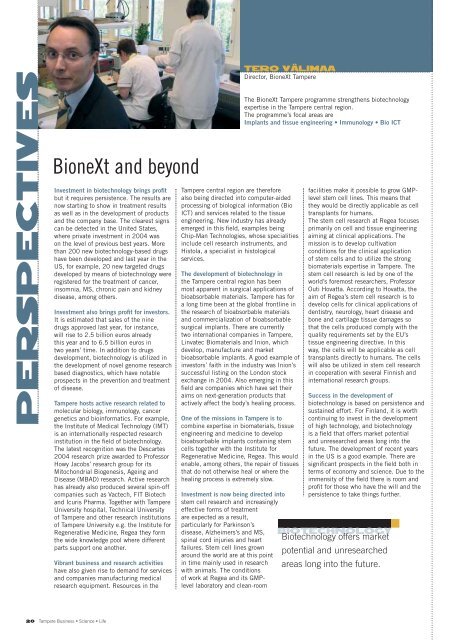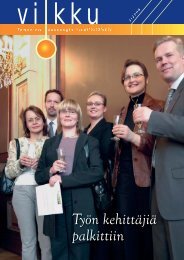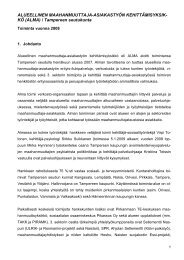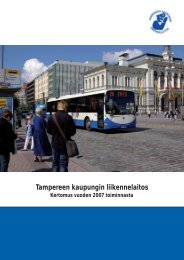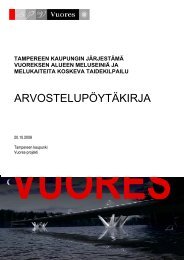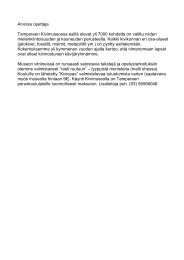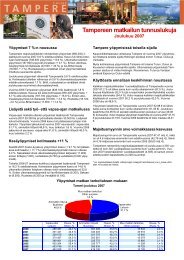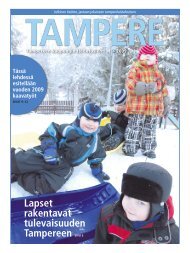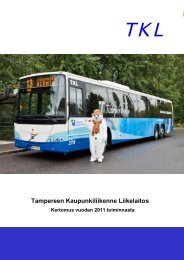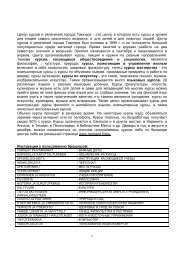- Tampere seizes creative economy
- Tampere seizes creative economy
- Tampere seizes creative economy
Create successful ePaper yourself
Turn your PDF publications into a flip-book with our unique Google optimized e-Paper software.
PERSPECTIVES<br />
BioneXt and beyond<br />
Investment in biotechnology brings profit<br />
but it requires persistence. The results are<br />
now starting to show in treatment results<br />
as well as in the development of products<br />
and the company base. The clearest signs<br />
can be detected in the United States,<br />
where private investment in 2004 was<br />
on the level of previous best years. More<br />
than 200 new biotechnology-based drugs<br />
have been developed and last year in the<br />
US, for example, 20 new targeted drugs<br />
developed by means of biotechnology were<br />
registered for the treatment of cancer,<br />
insomnia, MS, chronic pain and kidney<br />
disease, among others.<br />
Investment also brings profit for investors.<br />
It is estimated that sales of the nine<br />
drugs approved last year, for instance,<br />
will rise to 2.5 billion euros already<br />
this year and to 6.5 billion euros in<br />
two years’ time. In addition to drugs<br />
development, biotechnology is utilized in<br />
the development of novel genome research<br />
based diagnostics, which have notable<br />
prospects in the prevention and treatment<br />
of disease.<br />
<strong>Tampere</strong> hosts active research related to<br />
molecular biology, immunology, cancer<br />
genetics and bioinformatics. For example,<br />
the Institute of Medical Technology (IMT)<br />
is an internationally respected research<br />
institution in the field of biotechnology.<br />
The latest recognition was the Descartes<br />
2004 research prize awarded to Professor<br />
Howy Jacobs’ research group for its<br />
Mitochondrial Biogenesis, Ageing and<br />
Disease (MBAD) research. Active research<br />
has already also produced several spin-off<br />
companies such as Vactech, FIT Biotech<br />
and Icuris Pharma. Together with <strong>Tampere</strong><br />
University hospital, Technical University<br />
of <strong>Tampere</strong> and other research institutions<br />
of <strong>Tampere</strong> University e.g. the Institute for<br />
Regenerative Medicine, Regea they form<br />
the wide knowledge pool where different<br />
parts support one another.<br />
Vibrant business and research activities<br />
have also given rise to demand for services<br />
and companies manufacturing medical<br />
research equipment. Resources in the<br />
<strong>Tampere</strong> central region are therefore<br />
also being directed into computer-aided<br />
processing of biological information (Bio<br />
ICT) and services related to the tissue<br />
engineering. New industry has already<br />
emerged in this field, examples being<br />
Chip-Man Technologies, whose specialities<br />
include cell research instruments, and<br />
Histola, a specialist in histological<br />
services.<br />
The development of biotechnology in<br />
the <strong>Tampere</strong> central region has been<br />
most apparent in surgical applications of<br />
bioabsorbable materials. <strong>Tampere</strong> has for<br />
a long time been at the global frontline in<br />
the research of bioabsorbable materials<br />
and commercialization of bioabsorbable<br />
surgical implants. There are currently<br />
two international companies in <strong>Tampere</strong>,<br />
Linvatec Biomaterials and Inion, which<br />
develop, manufacture and market<br />
bioabsorbable implants. A good example of<br />
investors’ faith in the industry was Inion’s<br />
successful listing on the London stock<br />
exchange in 2004. Also emerging in this<br />
field are companies which have set their<br />
aims on next-generation products that<br />
actively affect the body’s healing process.<br />
One of the missions in <strong>Tampere</strong> is to<br />
combine expertise in biomaterials, tissue<br />
engineering and medicine to develop<br />
bioabsorbable implants containing stem<br />
cells together with the Institute for<br />
Regenerative Medicine, Regea. This would<br />
enable, among others, the repair of tissues<br />
that do not otherwise heal or where the<br />
healing process is extremely slow.<br />
Investment is now being directed into<br />
stem cell research and increasingly<br />
effective forms of treatment<br />
are expected as a result,<br />
particularly for Parkinson’s<br />
disease, Alzheimers’s and MS,<br />
spinal cord injuries and heart<br />
failures. Stem cell lines grown<br />
around the world are at this point<br />
in time mainly used in research<br />
with animals. The conditions<br />
of work at Regea and its GMPlevel<br />
laboratory and clean-room<br />
TERO VÄLIMAA<br />
Director, BioneXt <strong>Tampere</strong><br />
The BioneXt <strong>Tampere</strong> programme strengthens biotechnology<br />
expertise in the <strong>Tampere</strong> central region.<br />
The programme’s focal areas are<br />
Implants and tissue engineering • Immunology • Bio ICT<br />
facilities make it possible to grow GMPlevel<br />
stem cell lines. This means that<br />
they would be directly applicable as cell<br />
transplants for humans.<br />
The stem cell research at Regea focuses<br />
primarily on cell and tissue engineering<br />
aiming at clinical applications. The<br />
mission is to develop cultivation<br />
conditions for the clinical application<br />
of stem cells and to utilize the strong<br />
biomaterials expertise in <strong>Tampere</strong>. The<br />
stem cell research is led by one of the<br />
world’s foremost researchers, Professor<br />
Outi Hovatta. According to Hovatta, the<br />
aim of Regea’s stem cell research is to<br />
develop cells for clinical applications of<br />
dentistry, neurology, heart disease and<br />
bone and cartilage tissue damages so<br />
that the cells produced comply with the<br />
quality requirements set by the EU’s<br />
tissue engineering directive. In this<br />
way, the cells will be applicable as cell<br />
transplants directly to humans. The cells<br />
will also be utilized in stem cell research<br />
in cooperation with several Finnish and<br />
international research groups.<br />
Success in the development of<br />
biotechnology is based on persistence and<br />
sustained effort. For Finland, it is worth<br />
continuing to invest in the development<br />
of high technology, and biotechnology<br />
is a field that offers market potential<br />
and unresearched areas long into the<br />
future. The development of recent years<br />
in the US is a good example. There are<br />
significant prospects in the field both in<br />
terms of <strong>economy</strong> and science. Due to the<br />
immensity of the field there is room and<br />
profit for those who have the will and the<br />
persistence to take things further.<br />
biotechnology<br />
Biotechnology offers market<br />
potential and unresearched<br />
areas long into the future.<br />
20 <strong>Tampere</strong> Business • Science • Life


